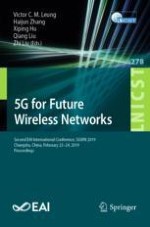2019 | Buch
5G for Future Wireless Networks
Second EAI International Conference, 5GWN 2019, Changsha, China, February 23-24, 2019, Proceedings
herausgegeben von: Victor C. M. Leung, Haijun Zhang, Xiping Hu, Qiang Liu, Zhi Liu
Verlag: Springer International Publishing
Buchreihe : Lecture Notes of the Institute for Computer Sciences, Social Informatics and Telecommunications Engineering
